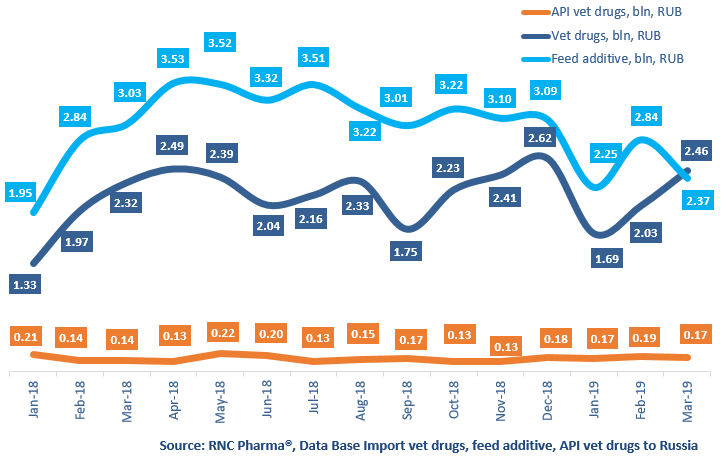Database Update: Import of Veterinary Drugs, Feed Supplements, and Veterinary APIs to Russia (March 2019)
Between January and March 2019, Russia imported 14.2 bln RUB worth of veterinary products (free circulation prices), which is in monetary terms (rubles) 1.8% higher than that of the same period in 2018. The dynamics of the import of veterinary drugs are +10% (6.2 bln RUB), which is the highest dynamics among the three groups. The lowest import dynamics belong to feed supplements, with -4.5% (7.5 bln RUB). The dynamics of the API import in monetary terms are +8.3%, with 529 bln RUB.
In physical terms (units), the dynamics of the import of veterinary drugs are +30%, with 7.3 mln units. Despite the import of feed supplements decreasing in monetary terms, the dynamics in physical terms are +11.6% (2.3 mln units). However, the dynamics of the API import are -5% (around 211 tons).
In March 2019, only the import of veterinary drugs has positive dynamics in both monetary and physical terms. It is also the first time in nearly 5 years (since July 2014) the import volume of veterinary drugs in monetary terms exceeded the import volume of feed supplements.
Among the top 20 largest importers of veterinary drugs, Bioproperties has the highest dynamics in monetary terms with a 6.7 times increase. It imports vaccines MS-H and Eimeriavax to Russia.
As for the top 20 importers of feed supplements, Innov AD NV (Belgium) is the absolute leader with a 4.3 times increase. It imported 12 feed supplements to Russia, with за Format and Escent having the biggest dynamics.
Among the API importers, Yabang-QH Pharmachem (Changzhou, China) Чанчжоу в КНР is noteworthy with a 6.7 times increase in monetary terms. It imported 3 APIs to Russia, with antihelminthic Albendazole accounting for the biggest part of the company’s import.
Dynamics of import of veterinary drugs, feed supplements, and veterinary APIs to Russia, free circulation prices including customs clearance, bln RUB (January 2018 – March 2019)

 Рус
Рус




